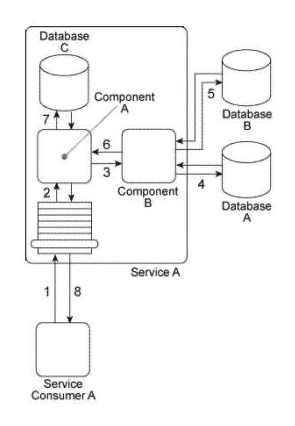Service Consumer A sends Service A a message containing a business document (1) . The business document is received by Component A, which keeps the business document in memory and forwards a copy to Component B (3) . Component B first writes portions of the business document to Database A (4) . Component B writes the entire business document to Database B and then uses some of the data values from the business document as query parameters to retrieve new data from Database B (5) . Next, Component B returns the new data back to Component A (6) , which merges it together with the original business document it has been keeping in memory and then writes the combined data to Database C (7) . The Service A service capability invoked by Service Consumer A requires a synchronous request-response data exchange. Therefore, based on the outcome of the last database update, Service A returns a message with a success or failure code back to Service Consumer A (8) . Databases A and B are shared and Database C is dedicated to the Service A service architecture.  There are several problems with this architecture: First, the response time of Database A is often poor, resulting in Component B taking too much time to provide a response to Component A. This results in Component A consuming too many runtime resources while it holds the business document in memory and it also causes unreasonable delays in responding to Service Consumer A. Additionally, Database B is being replaced with a different database product that supports a proprietary file format. This will disable the current interaction between Component B and the new Database B. What steps can be taken to solve these problems?
There are several problems with this architecture: First, the response time of Database A is often poor, resulting in Component B taking too much time to provide a response to Component A. This results in Component A consuming too many runtime resources while it holds the business document in memory and it also causes unreasonable delays in responding to Service Consumer A. Additionally, Database B is being replaced with a different database product that supports a proprietary file format. This will disable the current interaction between Component B and the new Database B. What steps can be taken to solve these problems?
Definitions:
Business Transactions
Economic events that are recorded in the financial statements of an entity because they affect the financial position of the company, involving the transfer of value between two or more parties.
Journal
A chronological record of all financial transactions, used to transfer information to a company's ledger.
Ledger
A book or collection of financial accounts of a particular type, often referred to as the final book of entry where transactions are summarized.
Trial Balance
A trial balance is a bookkeeping report that lists the balances in each of an organization's general ledger accounts to check the mathematical accuracy of the accounting entries.
Q7: Service A is a task service that
Q18: Our service inventory contains the following three
Q23: When presenting a single volume to multiple
Q26: _ are contracts with the insurer which
Q48: Which of the following statements makes sense?<br>A)
Q64: A network engineer is planning to deploy
Q66: You have twelve 500 GB drives and
Q89: Project Team Alpha delivers Service A for
Q91: Direct serving loans method requires a system
Q219: _ is a special variation on a